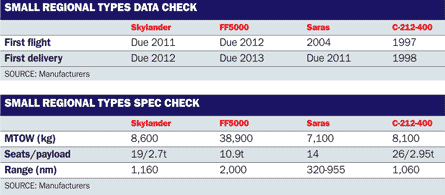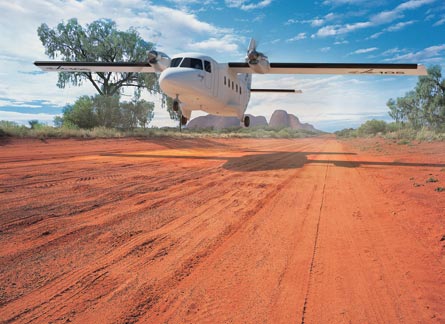Bringing new small niche aircraft to the market remains a struggle in terms of finance and acceptance, despite a growing need to replace the many ageing types and address emerging market sectors.
The high-wing turboprop EADS Casa C-212 is now being exclusively assembled by Indonesian Aerospace at Bandung in its C-212-200 and C-212-400 variants. IAe will manufacture six more -200s and then will switch over to the newer -400 model, the first of which is scheduled to be completed in 2011.
However, a 10-aircraft agreement with local airline Merpati Nusantara never progressed into a firm order and prospects for the aircraft are not propitious. This has prompted IAe to resurrect its own N219 project, primarily for the local market. IAe says it needs firm orders for at least 30 aircraft to officially kick-start the three-year programme. The high-wing, twin-engined N219 will offer three-abreast seating for 19 passengers in one of the largest passenger cabins in its class. It will probably be powered by Pratt & Whitney Canada PT6s, and will have STOL capability.
|
|---|
SARAS STALLED
The turbulence surrounding the development of India's first indigenous aircraft, the 14-seat twin-pusher turboprop NAL Saras, continues. Doubts are being raised over this long drawn-out project ever coming to production.
A report by India's Directorate General of Civil Aviation into the fatal crash of the second prototype in March 2009 is critical of aircraft developer, the National Aerospace Laboratory. The DGCA accuses NAL of having contracted out almost the complete design and development work on the Saras, including flight-test analysis, to a private agency - Bangalore-based Aircraft Design and Engineering Service - without putting in place adequate safeguards.
As the Saras is a national project, the DGCA says employing a private contractor should be discontinued immediately and it says the probable cause of the crash could have been the incorrect re-light of the second engine by cutting off the working first engine at an insufficient height, leading to rapid loss of altitude. Lack of crew co-ordination and cockpit procedures were also a contributing factor.
It is believed that work is continuing on a production standard aircraft that will make greater use of composites to reduce the aircraft weight by 500kg (1,100lb) and bring it closer to its desired design weight of 7,100kg. The Indian air force maintains its interest in acquiring 15 aircraft, with the Indian coastguard also considering the Saras as a Dornier 228 replacement.
NAL will probably need to revise its projection for a demand for 250 aircraft over the next 15 years. Delays to the Saras programme will also affect plans for a larger 25-seat Saras-S and longer-term joint efforts between NAL and Hindustan Aeronautics for the 70-seat RTA-70 regional transport. The Saras is aimed at commuter, cargo, ambulance, executive, border control, and military transport operations.

NO PRESSURE
Sky Aircraft, a subsidiary of GECI Aviation, has cut first metal for its SK-105 Skylander twin-turboprop utility aircraft after making major design changes, to increase the economic speed, improve take-off and landing performance, and offer greater range with maximum payload.
These targets resulted in the deletion of the strut between the landing gear sponson and the wing, a reduction in the number of main landing gear wheels from four to two, and an extended, more aerodynamically efficient nose and cockpit.
Also introduced were changes to the profile of the leading edge of the wing and double-slotted trailing edge flaps. A model showing the new configuration was exhibited at the ILA air show in Berlin in May. First metal was cut in May at its production site on a former NATO military base at Chambley-Buissières in the Lorraine region of France.
Powered by two 1,100shp (820kW) Pratt & Whitney Canada PT6A-65B turboprops driving five-blade Hartzell propellers and a glass cockpit, the high-wing, unpressurised Skylander is designed to carry up to 19 passengers or 2.7t of freight and operate from short, rough airstrips. Envisaged uses include commuter, passenger/cargo combi, freight, paratroop transport and aerial ambulance operations.
The industrial ramp-up calls for four prototypes to be constructed so ground and flight testing can begin in 2011. First flight is due in the second half of 2011 and first delivery for late 2012. Turkish freight carrier ACT Airlines, which has signed a letter of intent for 15 aircraft, is set to take delivery of the first batch.
A memorandum of understanding covering four Skylanders signed at the 2009 Paris air show was followed at the Dubai air show by Global Aerospace Logistics' letter of intent to take 10 aircraft. Early this year, the UAE signed an MoU for 10 aircraft for its air force. GECI expects to be able to build nine Skylanders a year from 2015. Breakeven is given as 180 aircraft.
The Reims F406 unpressurised twin-turboprop is also in GECI's stable after the integration of Reims Aviation Industries into the company in March. The aircraft has been proven in many surveillance tasks, including maritime and land patrol, with its extra wide cabin for sensors and workstations cited as advantageous. A quick-change interior can facilitate conversion from a 14-seat commuter aircraft to VIP, cargo, or ambulance configuration.
FEEDING DEMAND
US company Freight Feeder is in the process of building a flying proof-of-concept prototype of its proposed FF4000 freighter, which it hopes to complete by the end of 2010, after which it will begin the US Federal Aviation Administration Part 25 certification process.
The certification programme is expected to take 18 months, with first delivery to customers in 2013. Production of 48 FF4000 and FF5000s is envisaged for the first three years. All aircraft will be built by Metalcraft Technologies at Cedar City, Utah. The company's production capacity will allow it to build 672 aircraft in the first eight years, which it expects to constitute an 11.2% share of a 6,000-unit market for this type of aircraft. Such ambitious targets, however, appear highly unrealistic.
The FF4000 and its larger sister ship, the FF5000, are all-aluminium twin-engine high-wing turboprop aircraft specifically designed as utility aircraft for feeding containerised air cargo from smaller airports into major hubs. The two aircraft have the same cross-section and can accommodate four AMJ and six M-1 containers respectively via a rear cargo door.
Also being considered is the FF5000MW special missions variant. All three types, powered by Pratt & Whitney Canada engines, will have a design range of over 2,000nm (3,700km) and can operate from runways as short as 1,050m (3,500ft). The targeted market niche includes the overnight/two-day express airlines, postal services, passenger/cargo airlines and third-party logistics companies.
The Polish-built PZL Mielec M28-05 Skytruck - a high-wing, Pratt & Whitney PT6A-65B-powered 19-seat utility STOL aircraft, certificated by the European Aviation Safety Agency and the US FAA - continues to be produced in limited numbers, with sales primarily in the military market through the M28B Bryza variant. Substantial civil sales appear unlikely for this high-wing, twin-fin utility STOL aircraft, which seats 20 people.
Czech company Evektor hopes its new EV-55 Outback - which has only 14 seats, but a low price of $1.9 million and a range of over 1,000nm - will appeal to Russia's regional airlines, especially if its plans for production by Aviastar at Ulyanovsk come to fruition. The aircraft is touted as an ideal replacement for large numbers of Antonov An-2 biplanes still operated in remote areas.
Source: Flight International















